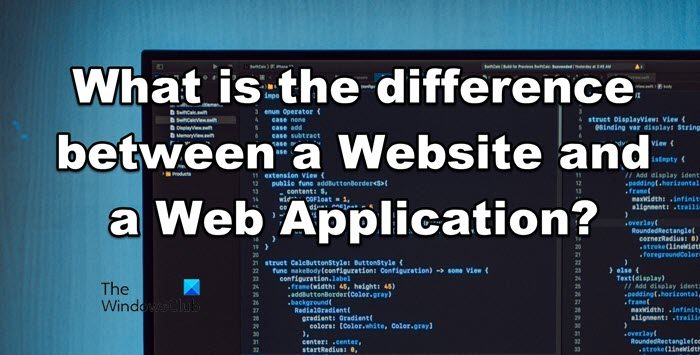A Website and a Web Application need web access and employ the same coding paradigms. A website is a group of interconnected web pages, but a web application is a piece of software that is accessible via the browser, which is a tool used to surf the web. The website features photographs, text, audio, and video, among other media types. It could include as many pages as one desires. There is a lot of difference between a Website and a Web Application, in this post, we will be explaining them to you.

Difference between a Website and a Web Application
Several parallels can be drawn between web pages and web applications. Many people argue that web applications represent a more nuanced step in the advancement of websites. Nonetheless, there are significant distinctions between these two concepts that must be examined. In this post, we are going to cover the following three things to understand the difference between a Website and a Web Application in detail.
- What is a Website
- What is a Web Application
- The distinction between websites and web apps
Let’s get started.
1] What is a Website
The viewer of the website is only able to view the content of the website; they are unable to alter or change it in any way. There is no need for this to be precompiled. The operation of the website is rather uncomplicated. Users do not interact with the website. The website comes with a browser that has a lot of different functions. On the website, login is not required at any time. Integration is less difficult with regard to the website. Some websites include Breaking News and the website for Aktu, amongst others.
The basic parts of a website are the Header & menu, Images, Website content, and footer. When a website is created, mostly, HTML and CSS are used to create these parts. HTML is there to provide structure, whereas, CSS adds aesthetics to the website.
Read: Best Code Editors for Windows that every developer must be using.
2] What is a Web Application
A web application was created in order to interact with end users. The user has access to view the site’s content as well as the ability to alter the data. Before the launch, the app needs to be pre-compiled. The functionality of the web application is pretty intricate. Individuals may interact with the online application using their browser. The features of a web browser are extensive and come equipped with online applications. Authentication is required for the majority of web applications. Integration is difficult for web applications since it entails the handling of sophisticated functions. Web apps include things like Amazon and Facebook, amongst others.
There are various types of web apps such as Static web applications, Dynamic web applications, E-Commerce web applications, Single-page web applications, Portal web applications, Content management system web applications, Animated web applications, and Rich Internet web applications.
Read: Best Progressive Web Apps (PWA) that you can use right now
3] The distinction between websites and web apps
The following are key points of distinction between web apps and websites:
- Utility
- Sophisticated Technologies
- Access
Now, let us talk about these in detail.
Utility
The primary distinction between websites and web apps, from the standpoint of the user, is utility. Websites help to inform, while web applications serve to assist. A website’s content may be seen, read, or heard, but it can’t be manipulated. Web application content, on the other hand, is not just visible but also interactive. Users may modify data via web apps. A questionnaire is a basic example of engaging online content. A web app is anything on the Internet that offers a service.
Sophisticated Technologies
Websites are significantly less sophisticated than web apps. Websites are nothing more than a compilation of basic web pages. Although new and professional web technologies have resulted in websites with more dynamic and complex elements, they are still relatively easier to design than web apps. Web applications do not only offer services and perform efficiently; they also need backend services, different user levels, and data processing capabilities. Furthermore, web application security concerns require increasingly sophisticated alternatives. Although web apps may be developed using the same existing technologies as websites, including JavaScript, HTML, and CSS, they would also require the use of more complex programming languages, such as PHP, frameworks, and server-side scripts.
Access
Websites are defined by their ability to be accessed by the general public; however, the vast majority of online apps call for account creation and authorization. However, website users who have not signed up for an account often enjoy the same accessibility as users who have signed up for an account. On the other hand, users almost always have to sign in to use web applications because these apps are made to meet the specific needs of each user. Using banking apps is a great example of how this works in the real world. It is true that all account holders have access to the same services, but each user gets a different experience since their personal financial information is used to customize their interactions with the website.
Leave a Reply